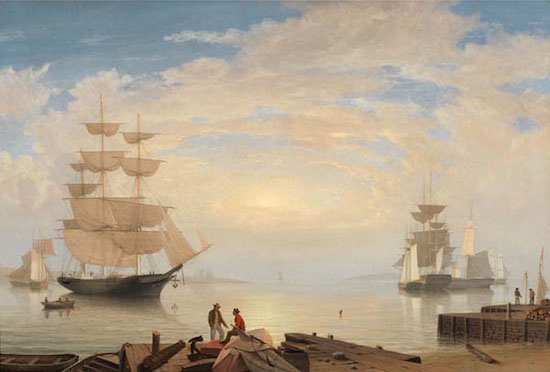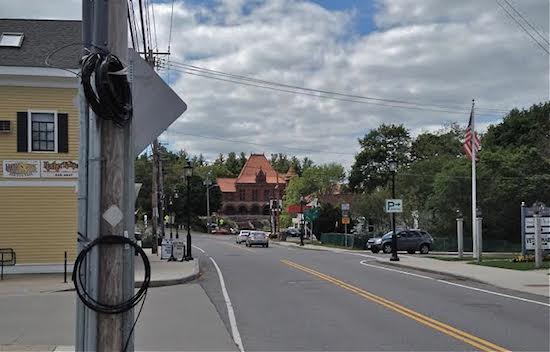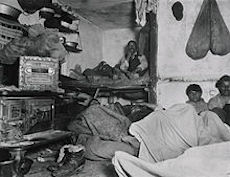Douglas, Heron and Co., popularly known as the Ayr Bank, had closed its doors amidst a run in June 1772. A handful of local noblemen and gentry, mostly large landowners, had founded it a few years before to fund improvements in southwest Scotland’s booming linen industry and tobacco trade. But they had been foolish in their lending. News that the bank’s London agent had been caught short speculating in East India Company shares and had fled to Europe now started a run that had turned into a nationwide panic.
The failure of the Ayr Bank was threatening to drag down not only the Scottish banking system but much of the best part of the economy of Scotland as well, including the great Carron Iron Works. English banks, too, were shutting up. Even the Bank of England was thought to be in danger of running out of gold.
Barely 60 years had passed since the parliaments of England and Scotland had agreed in 1707 to form the United Kingdom of Great Britain, under the Stuart monarchy. To that point Scotland had tended to send its most ambitious bankers abroad – John Law to Paris, where he started the Mississippi Company; William Patterson to London, where in the 1690s he worked out plans for the Bank of England and became an organizer of the Darien scheme, a disastrous attempt to found a Scottish colony in a swamp on the Isthmus of Panama.
Thanks to the Darien fiasco, Scottish bankers avoided the even greater losses that London suffered in the South Sea Bubble of 1720. Now bankers had good reason to stay home, for Scotland’s entry into the English trading system meant prosperity after many years of want.
A great boom had begun in western Scotland after “the Forty Five” – the last attempt to restore the Catholic Stuart monarchy, deposed in 1688. It ended when Bonnie Prince Charlie abandoned his march on London in Derby and, eventually, after a great battle at Culloden, in northwest Scotland, was put to flight. Glasgow’s trade with North America expanded rapidly, especially its linen export and tobacco import trade. Slave-trade profits were pouring in to Britain. New ideas were in the air — canals, roads and. harbors. Edinburgh joined Amsterdam, Antwerp, Hamburg, Stockholm and London itself as a center of finance. By mid-century Scottish banks were probably the most innovative in the world.
The first Scottish bank outside of Edinburgh opened in Aberdeen, in 1749; in Glasgow, the Ship Bank opened the next year. Soon new banks were starting up in provincial towns — six in Perth alone, in 1763. In Glasgow, the Ship, the Arms and the Thistle Banks, were making use of the “optional clause,” meaning they could suspend payment in gold or silver when they wanted, which made for much easier credit. The two public banks, the Bank of Scotland and the Royal Bank of Scotland, urged London to clamp down, either to give them a monopoly or require the private banks to keep reserves.
The government replied with a ringing declaration of the doctrine of free banking, based on the conviction that banking was a business like any other: “The right of banking is not a matter of Publick Favour but of Right to every subject in Common.” (Smith, a boyhood friend of the royal commissioner, may have been consulted in the matter, as he was in London at the time.) The backers of the Ayr Bank drew up their plans.
From the day it opened its doors, in 1769, however, the Ayr Bank’s lending was too easy. So great was the enthusiasm for new ventures that its own officers were taking out loans, even before they had paid in the capital they promised. The two great national banks cut lending back sharply rather than compete with the free-wheeling upstart. Within a couple of years, Ayr’s notes, its promises to pay, were said to be two-thirds of the currency of the country. The upstart was thoroughly disliked by the establishment.
In the spring of 1772, the 25-year boom was coming to an end. Business conditions were uncertain. Noteholders wanted sterling for their paper. Word was out that Ayr was paying 8 percent in interest and commissions to cart silver up from London to meet the claims against it. In May a London bank which had extensive dealing with Ayr failed; its proprietor fled to Europe. When word reached Edinburgh, the Ayr Bank, too, closed its doors. Soon most of the rest of Scotland’s private banking system was shutting down too.
The panic reached the London banks; most of them held at least some Ayr paper. Even the Bank of England was feared threatened in some degree. David Hume wrote to his friend Adam Smith about the crisis at the time:
the continual bankruptcies, universal Loss of Credit, and endless Suspicion…. Even the Bank of England is not entirely free from Suspicion. Those of Newcastle, Norwich, and Bristol are said to be stopp’d; the Thistle Bank has been reported to be in the same Condition; the Carron Company is reeling, which is one of the greatest Calamities of the whole; as they gave Employment to near 10,000 people. Do these Events in any-wise affect your theories?
They did indeed – enough to delay by some months the publication of An Inquiry into the Nature and Causes of the Wealth of Nations. Adam Smith’s protégé, the young Duke of Buccleuch, was among the founders of the Ayr Bank. Indeed, Smith himself may have been consulted when Parliament overruled the objections of the publicly-chartered national banks to authorize the free entry of private banks into the business of lending. Buccleuch and Smith had spent two years traveling around France and Switzerland. They returned in 1766. Now the youth whom Smith had been hired to tutor was at serious risk of losing most or even all of his titled lands. And the Scottish economy was suffering the effects of a major crash.
Over the next few months Smith added several paragraphs to the extensive discussion of money, banking and credit he had tucked away in Book Two of The Wealth of Nations. It was true, Smith admitted, that the Ayr Bank had been more liberal than any other Scottish bank ever had been. “The design was generous, but the execution was imprudent, and the causes of the distress which it was meant to relieve were not, perhaps, well understood.” Ayr’s abandon had enabled the big national banks to exit the “fatal circle” of speculation, he implied, that the big banks initiated.
At least Ayr had been making good loans; had it been operated by politicians, the results would have been worse. It was a generous benediction. Sydney Checkland, of the University of Glasgow, many years later would describe the episode as one of “naiveté bordering on knavery.” The panic it engendered had been successfully swept under the rug.
Behind the scenes, Smith was helping to arrange a government rescue of his patron and the other shareholders, who were left owing awesome sums. Buccleuch and his friend the Duke of Queensbury alone had been sued by the Bank of England for 300,000 pounds, a staggering sum. Smith wrote an old friend in Parliament who, like Hume, had inquired about the crisis: “Tho I have no interest myself in the Public calamities, some of the friends for whom I interest myself the most have been deeply concerned in them; and my attention has been a good deal occupied about the most proper method of extricating them.”
The only way they could hope to pay their debts without selling most of their lands was to borrow long-term through the sale of annuities. It would be expensive, but in due course Parliament authorized the measure and guaranteed the debt. Thus Adam Smith was the author of a historic bank bailout. Once that arrangement was in place, the young Duke was installed as governor of the Royal Bank of Scotland, in 1774, despite having blown up the Scottish economy a couple of years before. Not until 1832 were the Ayr bankers’ obligations fully discharged.
Smith’s disdain for a rival may have colored his views. Sir James Steuart is little remembered now, but in Smith’s day he was a well-known and controversial figure, secretary to Prince Charles, the pretender to the throne who led the insurrection in 1745. Steuart had spent 20 years afterwards traveling the financial capitals of Europe; he had a good feel for recent experiences of rapidly growing economies over a broad area of Britain and Europe. In 1767, Steuart had published an ambitious treatise, An Inquiry into the Principles of Political Oeconomy, to an indifferent reception.
Steuart was not what Smith would have called a mercantilist. He was too canny a Scot to believe that the government should direct trade. He was, however, a close observer of market conditions, especially on the Continent. At heart, he was what today we would call a reformer, an advocate of governmental interventions of various kinds, including employment policy, infant-industry protection, and, of course, bank supervision. His book included, as a cautionary tale, a detailed and generally sympathetic account of the meteoric rise and disastrous collapse of John Law’s bank in the famous “Mississippi bubble” of 1719.
In Steuart’s view, a “statesman,” meaning a regulator, would be required to oversee the banking industry, to superintend its structure and deal with the occasional panics that inevitably arose since bankers regularly became carried away.
To which Hume privately remarked to Smith: “The superiority which England has at present over all the world, is owing to her excluding statesmen from the executive part of all commercial concerns.” Smith himself wrote a friend: “I have the same opinion of James Steuart’s book that you have. Without once mentioning it, I flatter myself, that every false principle in it, will meet a clear and distinct confutation in mine.” Smith’s view has become known as free banking — banks free to issue their own paper currency, requiring no more regulation than any other business, with no state bank to serve as lender of last resort.
The Wealth of Nations finally appeared in 1776, to considerable acclaim. The magnitude of the achievement made it easy to overlook whatever embarrassment that had preceded it. Smith’s account of the workings of what we now call the price system was routinely compared to that of Newton. Where Newton was made Master of the Mint, the Duke of Buccleuch now arranged Smith’s appointment as Scotland’s Commissioner of Customs. He has been remembered ever since as the founder of modern economics. Steuart’s reputation suffered greatly for having been so studiously ignored. He died in 1780, thoroughly discouraged.
And so the story of the Ayr Bank was forgotten – forgotten, that is, by all but the bankers. They well understood the damage that the venture had done to their fortunes, to the economy of Scotland, and, a little less clearly, to sound policy itself. The very possibility of central banking had, through a certain sleight of hand (“without once mentioning it…”), been excluded from the purview of political economy at the very beginning. It would work its way back in, soon as practice, gradually as history, and finally as theory. Not until 1962 would central banking enter in the center spotlight of what by then had become known as “macroeconomics.”
The two sly essays from which I cobbled together the main facts of this story — Douglas Vickers’ (“Adam Smith and the Status of the Theory of Money”) and Sydney Checkland’s (“Adam Smith and the Bankers”) — appeared in a volume of essays on the bicentennial of Adam Smith, edited by Andrew Skinner, then a reader in economics at the University of Glasgow. He became its Adam Smith Professor in 1994.
It was Skinner who shepherded into print a six-volume bicentennial edition of Smith’s works. He would have been the last man to divert attention from what, in the 1970s, a time of trial for economics, was essentially the rediscovery of the great economist’s investigations (hard though that that may be to believe today). But it was Skinner, too, who, in an interview in New York, in 1976, suggested that I buy the two volumes of Steuart he had edited for the Scottish Economic Society, published at bargain prices, and even then going out of print. I did. The handsome volumes sat on my shelf until the 2008 crisis caused me to look back at Smith’s views on banking crises. It was there that I found the trail to Steuart had left, Skinner and Checkland and Vickers had carefully marked.
In 1982 Skinner wrote up Steuart in the Scottish Journal of Political Economy as “Author of a System,” recommending that he be read along with Smith for the “undiminished relevance in the tensions which emerge from a comparison of two very different ways of looking at the economic process.” (He died, at 76, in 2011.)
The story of the Ayr banks is important in the present day for the light it casts on strategies that economists have followed since in 1776, thanks to the thinking caps furnished by Smith with blinders attached — or so I assert in next week’s episode. The story of the eclipse of the “very different” views of economic processes of the Catholic Steuart by the Protestant Smith is something else again — as timely as the headline on the front page of the Sunday New York Times last week: “Pope’s Focus on Poor Revives Scorned Theology.”
The good news is that Richard Sylla, the recently retired Henry Kaufman Professor of the History of Financial Institutions and Markets at New York University, plans to write a book about Steuart. The important differences between Smith and his rival have been overlooked by economists for a very long time.








